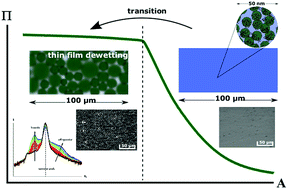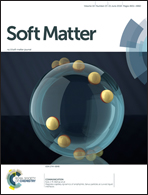Crossover from semi-dilute to densely packed thin polymer films at the air–water interface and structure formation at thin film breakup†
Abstract
A series of poly(n-butyl acrylate) (PnBA, 5 to 32 kg mol−1) homopolymers and diblock copolymers with poly(ethylene glycol) (PEG, constant molecular weight of 0.3 kg mol−1) is synthesized for the purpose of the investigation of quasi-2D polymer films at the air–water interface. The presented compression isotherms show a transition from θ solvent behavior for PnBA homopolymers to good solvent conditions when the volume fraction of the PEG in the block copolymers is increased by decreasing the molecular weight of PnBA. A transition from a semi-dilute regime to a densely packed layer is observed in the pressure isotherms for all the polymers. In the densely packed films we found first evidence for thin film breakup of a thin polymer film directly at the air–water interface. Combination of results from Brewster-Angle-Microscopy and Surface X-ray scattering provide a consistent picture of the film breakup. Our results suggest a preferred length scale of 2.5 μm. This scenario is analogous to a spinodal mechanism driven by thermal fluctuations of the film height.



 Please wait while we load your content...
Please wait while we load your content...